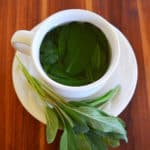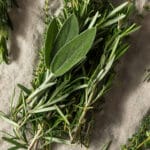Sage Benefits for Home, Health & Personal Care
Salvia means “to save”, and with all the wonderful benefits of sage, you’re sure to want it in your garden, kitchen & medicine cabinet. We’ll share simple tips to help you use this versatile herb.
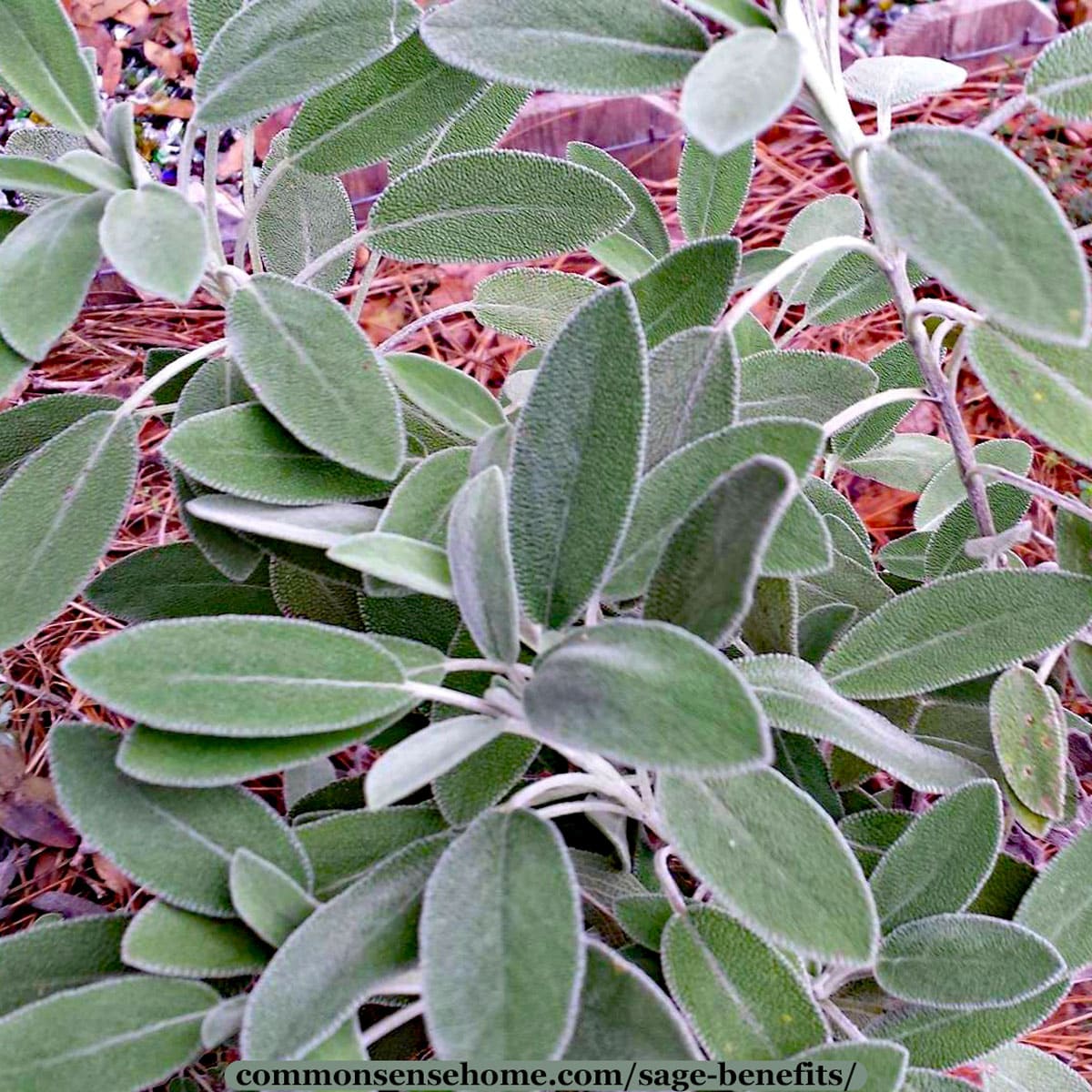
Sage (Salvia officinalis) is a perennial, evergreen subshrub, with woody stems, grayish leaves, and blue to purplish flowers. Salvia (sage) is the largest member of the mint family, containing over 900 species throughout the world.
Salvia has been highly regarded throughout history both for its culinary and medicinal properties. Its reputation as a panacea is represented in its scientific name, Salvia officinalis, derived from the Latin word, salvere, which means “to save“.
Tips for Growing Sage
- Sage flourishes in a sunny, sandy, well-drained, neutral spot in soil with a pH between 6.5 and 7.
- The plant is an evergreen perennial shrub in zones 5-8. In zones below 5 and above 8, it is considered an annual because it cannot survive all year in the growing conditions.
- Encourage air circulation with mulch and pebbles to help keep the area around the leaves dry.
- Prune plants back in early spring every year, cutting out the oldest growth in order to promote new growth.
- Replace your plants every 4-5 years for best productivity.
- Sage can be grown indoors in a sunny window.

Benefits of Sage for Cooking
Both Roman and Greek civilizations used sage as a preservative for meat, a tradition that continued until the beginning of refrigeration. What these cultures knew from experience that this herb could reduce spoilage, which is now being confirmed by science. Sage extracts act as food antioxidants, protecting oils from oxidation and preventing rancidity.
Sage cuts the fatty taste of heavy food, but also pairs well with vegetarian dishes. It has a fragrant aroma and an astringent but warm flavor.
Today it is typically used in:
- Stuffing, sausages, poultry and fish
- Vegetable dishes, especially with beans
- As a garnish in herb salads
- Seasoning Mixes
Opt for common sage (Salvia officinalis) for cooking, and save the purple, tricolor, or golden sages for other uses. The brighter varieties contain more camphor, which can ruin a recipe.
Easy Sage Recipes
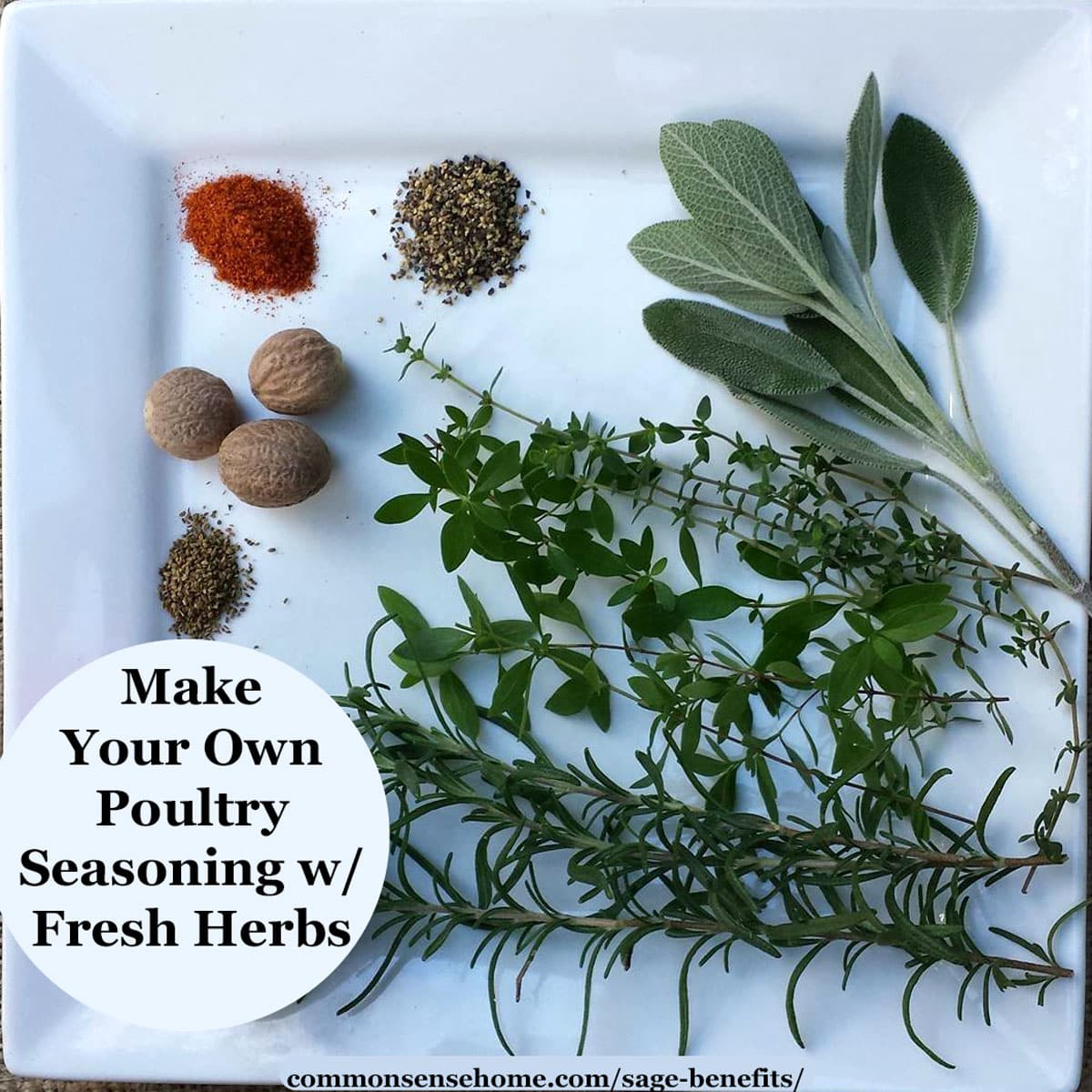
Poultry Seasoning Recipe with Fresh Herbs
A great way to dress up your chicken or turkey.
- Prep Time: 5 minutes
- Total Time: 5 minutes
- Yield: 34 teaspoons 1x
- Category: seasoning blend
Ingredients
- 3 tbsp. finely chopped thyme
- 3 tbsp. finely chopped rosemary
- 3 tbsp. finely chopped sage
- 1 tbsp. finely chopped marjoram
- 1/2 tbsp. freshly ground black pepper
- 1 tsp. celery seed
- 1 tsp. freshly grated nutmeg
- 1 tsp. smoked or regular paprika
Instructions
- Stir together all ingredients in a bowl. Seasoning will keep, refrigerated for about 3 days.
- You can mix this seasoning in a stick of unsalted butter to rub your turkey with prior to roasting or insert under the skin.
Nutrition
- Calories: 110
- Sugar: 1
- Sodium: 17
- Fat: 4
- Saturated Fat: 2
- Unsaturated Fat: 1
- Trans Fat: 0
- Carbohydrates: 22
- Protein: 4
- Cholesterol: 0
Find it online: https://commonsensehome.com/sage-benefits/
Sage Salt
This easy herbal salt makes a great gourmet gift.
Ingredients
½ cup sea salt (or any coarse salt)
¼ cup fresh sage leaves (chopped fine)
Directions
Mix together the leaves and salt and spread out on a cookie sheet with a lip edge. Bake at 200F for 25-35 minutes, until leaves are dry and crisp.
You can place Sage Salt in a food processor until fine for use in a salt shaker or leave coarse.
Making your own vitamin water is very cost effective not to mention your guest(s) and children will love them!
PrintSage Infused Water (Vitamin Water)
Infused water offers an array of healthy natural antioxidants and vitamins. They are visually stimulating, palate pleasing, and help to keep you hydrated.
Ingredients
- 1 cup of Fruit -cleaned and chopped in big chunks, do not chop berries (see notes for fruit suggestions)
- 1/4 cup Fresh Sage Leaves (regular or pineapple sage)
- Pitcher of Filtered Water
Instructions
- Add fruit to water. Rub sage between hands to bruise the herb and release the oils, add to water.
- Let sit at room temperature for 1-2 hours or in the fridge for 3-4 hours. The longer you infuse the water, the stronger the flavor.
- Discard fruit and herbs after 48 hours to prevent from spoiling. Store vitamin water in fridge up to three days.
Notes
Pair up your sage with
- Peaches
- Watermelon
- Grapefruit
- Blackberries
Nutrition
- Calories: 323
- Sugar: 8
- Sodium: 10
- Fat: 2
- Saturated Fat: 1
- Unsaturated Fat: 1
- Trans Fat: 0
- Carbohydrates: 78
- Protein: 6
- Cholesterol: 0
Find it online: https://commonsensehome.com/sage-benefits/
What are the benefits of burning sage?
Another way to use sage is in a smudge stick, which is a bundle of dried herbs that is burned to help purify the air and kill airborne bacteria. You can learn how to make a smudge stick in the “How to Get Rid of Unpleasant Smells” section of the DIY emergency potty post.
Many Native American tribes and herbal healers use smudging to clear negative energy from a space. Traditionally, smudge sticks use Salvia apiana (white sage or sacred sage).

Cleaning with Sage
To take advantage of the anti-microbial benefits of sage, try a sage vinegar infusion for cleaning. Gather enough fresh leaves to fill a pint jar. Rinse them and gently crush them with your hands until they are fragrant.
Pack the herbs into a glass jar, and cover with white vinegar. Infuse for 2-4 weeks, and then strain. When you’re ready to use your infusion, mix equal parts water and vinegar in a spray bottle. Use it as a general purpose surface cleaner.
Fragrant sage also acts as a pest repellent. Add it to nest boxes, or tuck herbal sachets in closets and pantries.
Sage Benefits for Health
In medicinal lore, sage has one of the longest histories of use of any herbal medicines. The rosmarinic acid (RA) that helps preserve foods also possesses health benefits. Sage contains many biologically active compounds, which are most concentrated in the leaves.
Health benefits of sage include:
- Antioxidant compounds provide protective effects from free radicals
- Anti-inflammatory, anti-allergic, anti-fungal, anti-viral and anti-septic properties
- Soothes bronchial asthma
- May help Alzheimer’s Disease- recent research suggests that sage essential oil improves memory
- Treats cold cores
- Throat Infections
- Gastrointestinal Issues
- May help regulate blood sugar levels. (See “Metformin-like effect of Salvia officinalis (common sage): is it useful in diabetes prevention?“)
- Eases menopausal symptoms such as night sweats and hot flashes. (See “The effect of Saliva officinalis extract on the menopausal symptoms in postmenopausal women“)
- Rich source of several B-complex groups of vitamins such as folate, thiamin, pyridoxine and riboflavin many times higher than the recommended daily level
- Contains very good amounts of vitamin-A and beta-carotene levels. Fresh sage leaves are a good source of vitamin C
Sage contains thujone, but a recent study confirms that short term medicinal use is safe.
Easy Sage Tea Recipe
- 1 Cup Boiling Water
- 3 Tbsp. Fresh Sage (rinse off and pat dry) or 1 Tbsp. Dried Sage
Pour water over sage leaves and let steep for 10 minutes, strain and add honey and lemon if desired. Drink or gargle tea several times per day for sore throats. Sip tea as needed for other ailments.
Note: A strong cup of Sage Tea can help relieve a nervous headache.
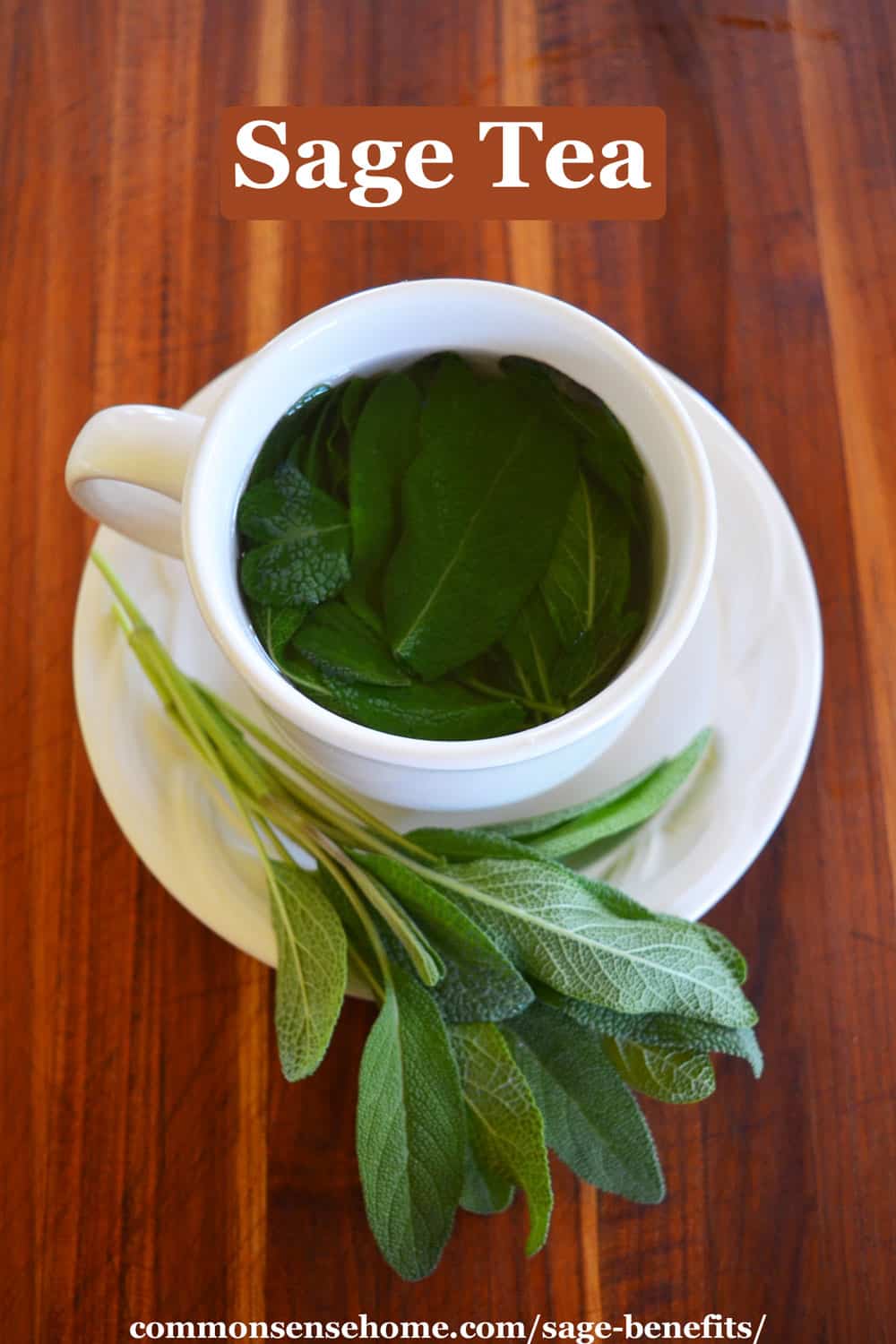
Sage Tincture
- Fresh Sage (Fill jar ¾ full with sage)
- Vodka (you can use vegetable glycerin in place of vodka)
- Glass jar with lid
Instructions
Wash and pat sage dry (thoroughly)
Place sage in clean glass jar ¾ of the way full
Pour vodka (or glycerin) over the sage, until the liquid is ½” above the leaves.
Cover tightly and place in a cool, dark place for a minimum of 2 weeks.
Shake the jar every couple days to help with the infusion.
Strain and pour tincture in a dark glass jar, preferably with a dropper, and store in a dark place.
You can gargle with sage tincture or take 5-10 drops twice daily at the first sign of a cold or use to treat sore throats. The phenolic acids in sage are particularly potent against Staphylococcus.
*Note: Avoid consuming sage if you are pregnant or nursing. It can decrease milk flow.
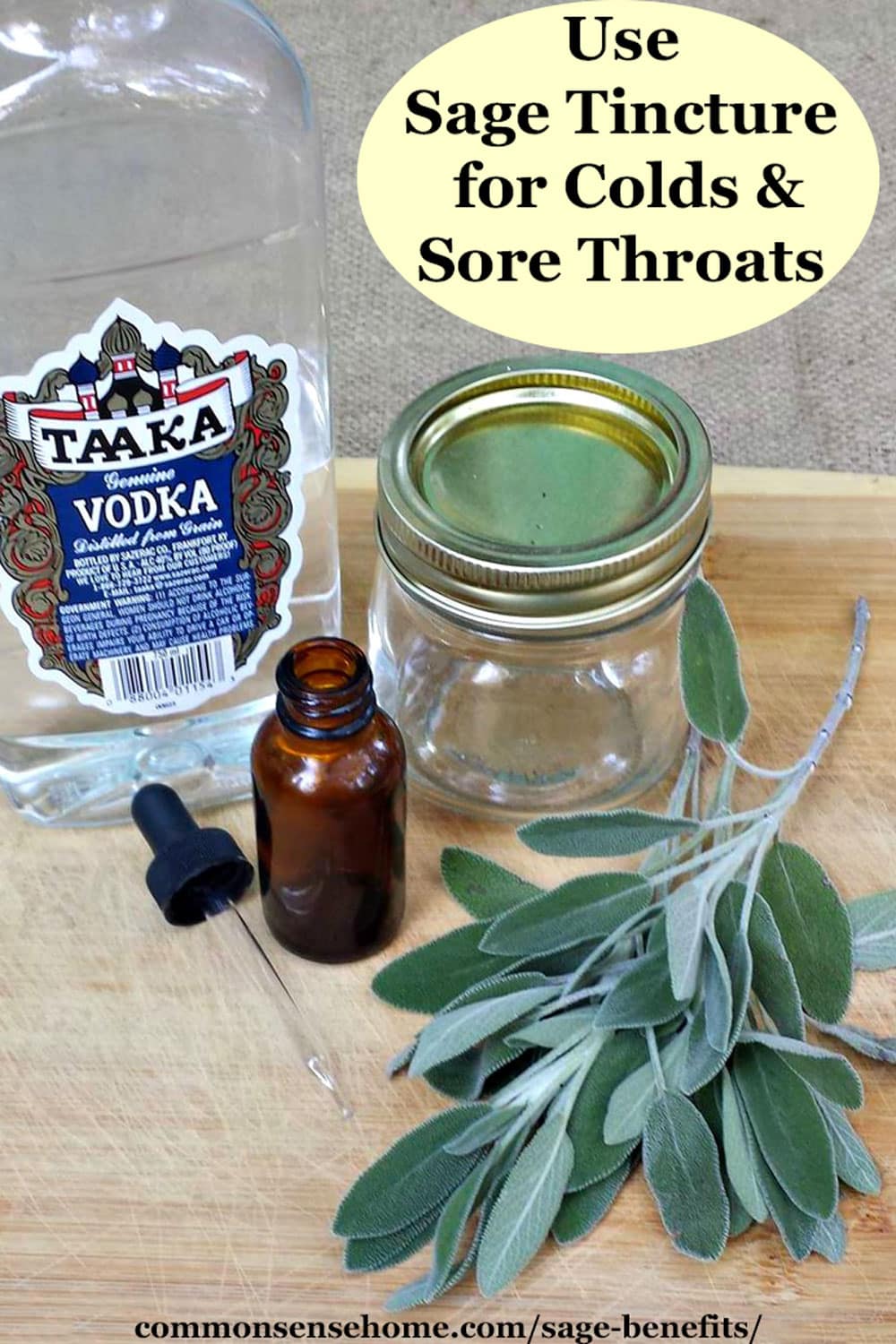
Disclaimer: This article is provided for general information only. Please see a healthcare professional if symptoms are acute or persistent.
Always consult your healthcare provider if you are on any medications. Side effects of sage are rare. Salvia species may have mild interactions with diabetes medications, anticonvulsants, and sedatives.
Benefits of Sage for Skin and Hair Care
Try sage tea as a soothing aftershave splash to tone and tighten skin. Make up a batch and store, covered, in the refrigerator for up to week.
To soften rough skin, mixed brewed sage with an equal amount of aloe juice. Apply as needed to areas such as elbows and heels. The tea can also be used as a hair rinse to help fight dandruff and scalp itch.
You may also enjoy:
- Best Cold Remedies
- Herbal Remedies for PMS
- How to Infuse Herbs in Oil, Water, Vinegar, Alcohol or Honey

This post is by Amber Bradshaw of My Homestead Life. Amber and her family live off grid on forty-six acres in the Smoky Mountains in East Tennessee.
Originally posted in 2015, last updated in 2021.

